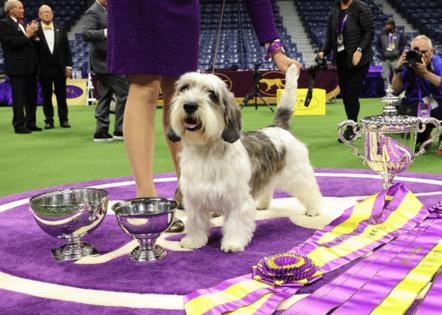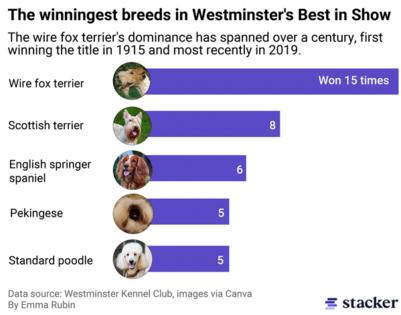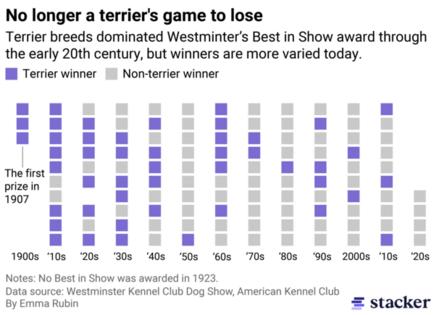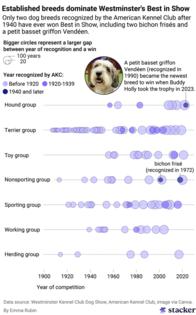What makes a Westminster Best in Show winner, based on a century of data
Published in Cats & Dogs News
On the second weekend of May 2024, over 2,500 dogs representing every U.S. state and 12 countries will strut across rings at the USTA Billie Jean King National Tennis Center, each having spent countless hours training and preparing for the event. While leaving with any prize from one of the most competitive dog shows in the U.S. is already an achievement, the biggest honor of the day is Best in Show.
Only 116 dogs have ever won the competition's most prestigious prize, representing 46 unique breeds. Stacker used data from the Westminster Kennel Club dog show and the American Kennel Club to explore trends in Best in Show winners since the start of the competition.
Just to qualify for the Westminster competition is a long journey. From an early age, owners balance dogs' diets, time regular grooming sessions, clean their teeth, and train them to patiently stand while a judge examines them.
"That five minutes in the ring doesn't seem like a lot, but to get them physically in condition both mentally and their muscle tone and their coat takes hours and hours each week," Lori Pelletier, who will be judging breed competitions for terriers at Westminster this year, told Stacker.
The Best in Show award draws from the group division winners of each group, who are pulled from the winners of individual breed shows. When Wasabi, the 3-year-old Pekingese, won in 2021, he first beat out eight others of the same breed and then other outstanding toy breeds to eventually face off against six winners from other dog groups.
Judges compare each dog to the ideal version of their breed, officially called the Standard. These are two- to three-page documents that detail every breed's "perfect" size, shape, and personality.
In German shepherds, for example, dark almond-shaped eyes, a muscular neck, and a powerful stride are some details judges will examine. Characteristics like a nose that isn't mostly black or hanging ears would disqualify the competitor.
When Pelletier is judging terriers, she is not only comparing each dog to the standard; she's looking for "terrier spirit." In other words, she's looking at how they move and present themselves relative to their historic roles as working dogs.
"The Norfolk and the Norwich [terriers] … have to have the spunk to go into a hole in the ground and corner that fox," she explained.
Judges only spend three minutes with each dog close-up, but according to Pelletier, the judging starts as soon as each one steps into the ring. She immediately notes the breed type and whether it has an attitude that captures her attention.
Visit thestacker.com for similar lists and stories.














Comments